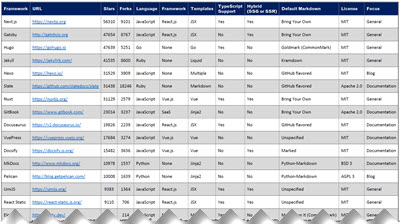Choosing a Static Site Generator
Choosing a static site generator can be difficult. Not long ago, Microsoft announced support for a new cloud service called Azure Static Web Applications. There are dozens if not hundreds of static site generators. This post will focus on the top 20 generators identified by Jamstack.
There are plenty of questions to ask when looking for a static site generator. You can use the chart I have created below (click the image) to help choose along with answering the questions below.
1. Choosing a Language and Framework
If you are using a static site generator within a team or organization, you’ll likely want to pick something that uses the languages and/or frameworks that are most familiar to the team. One of the benefits of a static site generator is to allow rapid development. If the entire team needs to learn something they are unfamiliar with, you’re losing this benefit.
There may be interest in trying something new. If that’s the case, I’d look for a generator that covers your interests.
In some cases, you can do both. If you look at the chart, you can find generators that all use TypeScript. As long as you’re familiar with TypeScript, a good portion of your skills will be able to transfer from generator to generator.
2. Extensibility
Many of the generators will take a markdown file and translate it to HTML. Some allow you to use templating for reusability and several also allow you to pull in data. Then there are generators that also allow integration with several tools you may use today such as a CMS or a product tool like Shopify. The extensions will help to cut down on development time and prevent you from reinventing the wheel.
3. Server Side Rendering
In some cases, you may need a hybrid approach and require server side rendering as well as the static site generation. There are some generators that offer this.
4. Support
If you are using this for a production application, you’re going to want support. Obviously the top generators will be more widely supported than the generators further down the list. Use sites like Stack Overflow or online forums such as Discord. Also be sure that the documentation is fairly self-explanatory. Just because a generator has a “Getting Started” page doesn’t mean that it’s a great tutorial to get started.
Hope this helps point you in the right direction. Again, feel free to look at the chart that I put together.
 Jason N. Gaylord
Jason N. Gaylord



